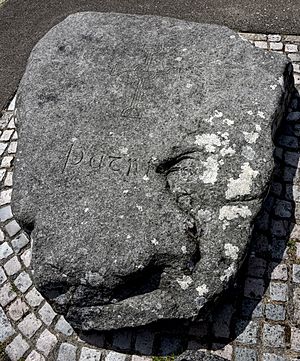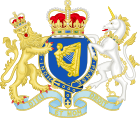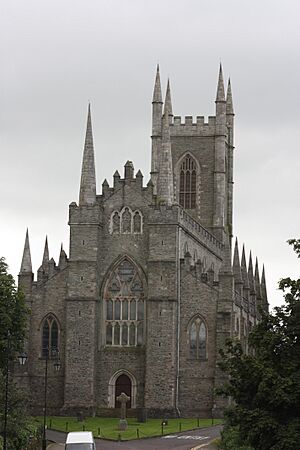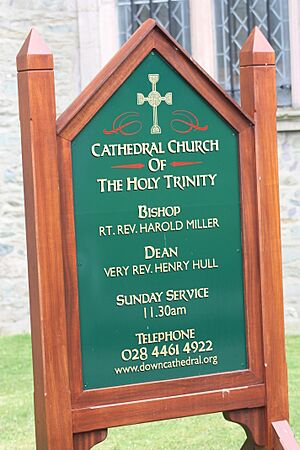Down Cathedral facts for kids

Down Cathedral, also known as the Cathedral Church of the Holy and Undivided Trinity, is an important church building in Northern Ireland. It belongs to the Church of Ireland, which is a Christian church. You can find it in the town of Downpatrick, sitting high up on Cathedral Hill and looking over the town.
This cathedral is one of two main churches in the Diocese of Down and Dromore. A diocese is like a special area that a bishop looks after. The other main church is Dromore Cathedral. Down Cathedral is a central part of Downpatrick, a town name that became common in the 1600s.
History of Down Cathedral
The history books tell us that St Fergus was the first bishop of Down. He was connected to the Down area around the late 500s.
Even though it's not as old or famous as nearby Bangor Abbey, there's no doubt that a group of monks lived near the hill overlooking the Quoile River during the time of the Celtic church. In those days, Christian communities often lived in monasteries.
At first, these buildings would have been made of wood. Stone buildings only started to appear around the 900s as building methods improved. Records show that the community at Down faced several attacks in the early 1000s, though not all of them were successful.
The cathedral is dedicated to the Holy Trinity, which means God as Father, Son, and Holy Spirit. This dedication was first written down in the 1100s.
In 1124, St Malachy became the Bishop of Down. He worked hard to fix and make the cathedral bigger. Later, in 1177, a Norman conqueror named Sir John de Courcy took over Ulster. He brought in Benedictine monks and sent away the older group of monks.
De Courcy had upset the king by taking more land in Ireland than he was allowed. He was captured at the cathedral on Good Friday in 1204. Stories say that de Courcy, even though he was unarmed, managed to grab a weapon from one of his attackers. He fought bravely, killing 13 men before he was finally overpowered and taken prisoner.
Down Cathedral received a special paper from the king, called a royal charter, on July 20, 1609. This charter gave the cathedral special rights and powers.
John Wesley, a famous preacher, visited Downpatrick four times between 1778 and 1789. Each time, he preached in a special area called the Grove on the hill of Down Cathedral. Today, you can still see a stone there that remembers his visits.
Restoring the Cathedral
The cathedral includes parts of a church built in the 1200s by the Benedictine Abbey of Down. This church was left in ruins after the monasteries were closed down in 1541.
Quick facts for kids Down Cathedral Act 1790 |
|
|---|---|
| Act of Parliament | |

Parliament of Ireland
|
|
| Long title | An Act for the more effectual Application of the Sum of One Thousand Pounds, granted by King's Letter, for the Support and Repair of the Cathedral Church of Down, and for defraying the Expences of the Celebration of Divine Worship therein. |
| Citation | 30 Geo. 3. c. 43 (I) |
| Dates | |
| Royal assent | 5 April 1790 |
The work to restore the ruined 14th-century cathedral in Downpatrick began after the Irish Parliament passed a law called the Down Cathedral Act 1790. This law provided £1,000 (which would be worth about £923 today) to help fix and support the cathedral.
The cathedral officially reopened for church services on August 23, 1818. Work on building a tower started later, and it was finally finished in 1829.
Today, the cathedral mainly uses the original main part of the church, called the chancel, from the 1400s. A vestibule (an entrance hall) and a tower were added later. The cathedral had another big restoration project from 1985 to 1987. During this time, the cathedral was closed for the work.
What You Can See Today
Inside the cathedral, you can find an old stone font made of granite from the 1000s. A font is a basin used for baptisms. This font was found in 1927 being used as a watering trough for animals! It was then moved and placed in the cathedral in 1931.
In the cathedral grounds, there is a place believed to be the burial spot of St Patrick, who is thought to have died in 461. However, the stone marker you see there today, made of Mourne granite, was actually put in place in 1900.
Outside the east end of the cathedral, there is a copy of an old high cross made of granite. The original cross, which is from the 900s or 1000s, used to stand in the middle of Downpatrick. It was moved to the cathedral in 1897 and has been on display in the Down County Museum since 2015.
Two smaller stone crosses are now built into a wall inside Down Cathedral. These crosses seem to be from the 1100s and are carved with pictures of monks holding books.



